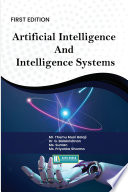The goal of imbuing artificial intelligence into robots has been actively pursued throughout the course of the last several decades. As a direct consequence of the proliferation of modern technology, artificial intelligence (AI) has become a crucial component of day-to-day life.
This change was brought about by a combination of factors. The book "Artificial Intelligence and Intelligent Systems" offers a thorough examination of the primary ideas and procedures associated with artificial intelligence.
This book explores recent developments in artificial intelligence (AI) and their applications in a variety of different areas. In order to promote a more in-depth knowledge of artificial intelligence (AI), many types of intelligent systems, including expert systems, genetic algorithms, fuzzy systems, artificial neural networks, and swarm intelligent systems, are dissected in detail and shown with examples.
The most recent advances in Al are used to solve real-world challenges, which are emphasized throughout the book. The term "artificial intelligence (AI) encompasses both the scientific research and the technological development that are required to produce intelligent devices, most notably intelligent computer programmes.
The entire word is known as artificial intelligence, but its abbreviation is Al. When a piece of machinery has the ability to think for itself, we say that it demonstrates artificial intelligence. The level of intellect, speech, and vision possessed by humans serves as a benchmark for the development of artificial intelligence.



